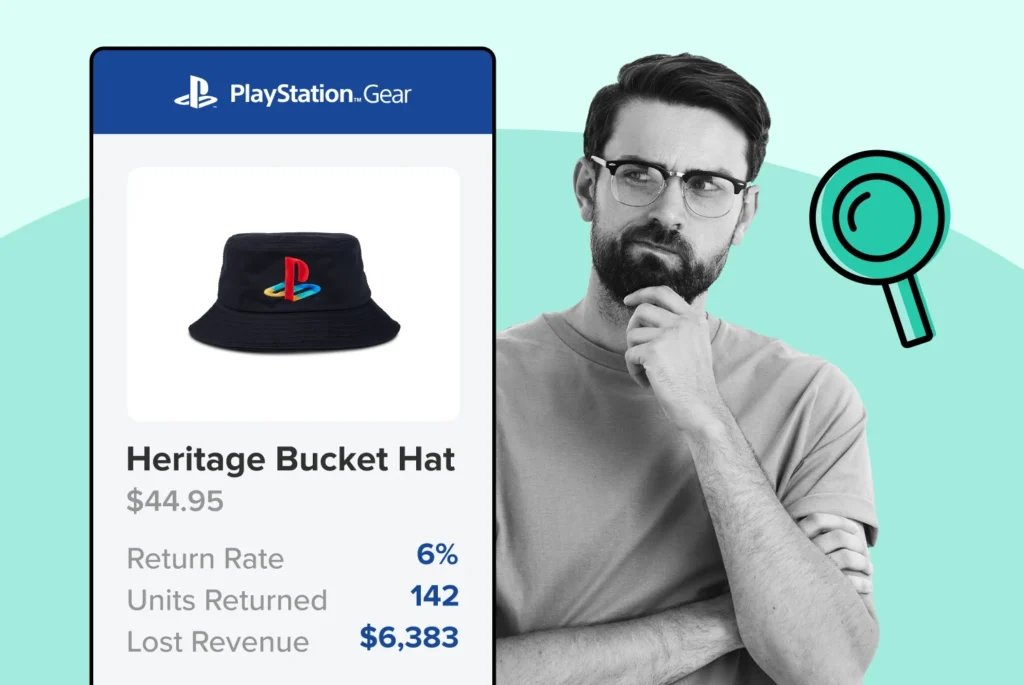
The Impact of Retail Analytics Programs
Let’s explore the tangible impact of retail analytics, revealing how it informs strategies, optimizes operations, and predicts market trends!
Boost customer experience and reduce support tickets
Realtime order and shipment tracking
Proactive order and shipping notifications
Predictive pre-purchase estimated delivery dates
Self-Serivce branded order tracking
Effortless experience delivered
Make returns profitable and delight customers
Flexibility to define any return destinations & conditions
Simplify returns for your customers and team
Incentivize exchanges over returns
Returns management made easy for your team
Understand why your customers are returning
Unify the online and the in-store experience
Hassle-free pickup experience for customers
In-Store Dashboard to keep operations streamlined
In-Store and Online orders unified
Drive foot-traffic to your stores
Boost customer experience and reduce support tickets
Realtime order and shipment tracking
Proactive order and shipping notifications
Predictive pre-purchase estimated delivery dates
Self-Serivce branded order tracking
Effortless experience delivered
Make returns profitable and delight customers
Flexibility to define any return destinations & conditions
Simplify returns for your customers and team
Incentivize exchanges over returns
Returns management made easy for your team
Understand why your customers are returning
Unify the online and the in-store experience
Hassle-free pickup experience for customers
In-Store Dashboard to keep operations streamlined
In-Store and Online orders unified
Drive foot-traffic to your stores
Find the answer to all your questions
Explore the most comon questions about WeSupply
Calculate the ROI that WeSupply can bring you
Request a no strings attached review of your current shopping experience and missed conversion opportunities
Take a step by step trip through our functionality to see how we can improve your ecommerce processes.
Read actionable articles on how to optimize your post-purchase experience and decrease support tickets
Get inspired by stories of how our customers implemented an effortless post-purchase experience
A Deep Dive into Top Companies' Order Tracking & Returns Strategy
Wondering if WeSupply is a good fit for you? Read through our use cases to see how we can help you increase conversion & improve CX!

Smart retailers understand that return data is more than a record of transactions – it’s a goldmine of insight that can sharpen competitive edge. By leveraging data analytics and machine learning, smart retailers can manage and reduce returns more effectively, gaining insights from returns data to understand customer behavior, refine inventory management, and drive strategic decision-making. This article tackles precisely how smart retailers use data for returns, not only to manage and reduce returns, but also to gain a deeper understanding of customer behavior, refine inventory management, and drive strategic decision-making. We’ll dive into the innovative approaches taking the retail world by storm, equipping you with actionable insights on harnessing the full potential of returns data. Get ready to transform the afterthought of returns into a cornerstone of your retail strategy.
Retailers can use returns data to understand customer behavior, identify product issues, and create data-driven strategies to optimize inventory management, enhance product offerings, and reduce return rates.
Leveraging AI and machine learning algorithms, retailers can analyze returns and other customer data for personalized marketing and recommendations, improving customer engagement and loyalty.
Effective management of returns, including streamlining the e-commerce return process and incentivizing in-store returns, can lead to increased customer satisfaction, additional sales, and improved overall retail efficiency.
WeSupply revolutionizes post-purchase management by empowering retailers with comprehensive data analytics. Key features include detailed retail analytics, SKU-level insights, advanced customer segmentation, machine learning for inventory management, and streamlined online and in-store return processes. These tools help businesses reduce return rates and enhance customer satisfaction efficiently. Ready to transform your returns management? Get started with WeSupply today!
Unlocking the secret of returns data can be a game-changer for businesses. It is not just about managing stock or processing refunds; it’s about understanding the customer journey, identifying trends, and leveraging consumer insights to enhance business strategies. Additionally, analyzing customer feedback from returns data can reveal valuable insights into product improvements and customer satisfaction.
For instance, recognizing a pattern in returned items might reveal an inventory issue or pinpoint a flaw in product design. This knowledge can be instrumental in improving the brand’s offering, boosting sales, and bolstering profits.
In the rapidly evolving retail industry, data analytics has emerged as a top investment priority for many retailers. It’s not hard to see why. Smart retailers know that data-driven insights can pave the way to increased customer engagement. Consider, for example, the role of returns data. By analyzing patterns in returned items, retailers can gain valuable insights into customer behavior, informing strategies ranging from promotions to supply chain management.
But the potential of returns data doesn’t stop there. It also helps in enhancing product descriptions, building trust with customers by providing accurate information and reducing discrepancies. Moreover, technology, particularly AI, has a significant role in managing returns. Retailers are utilizing AI-powered systems to analyze return requests, speed up the process, and ensure consistent decision-making. In fact, many online retailers have revamped their return strategies, adopting more lenient policies, and improving communication about return options and timelines.
Advancements in technology, particularly AI, have brought about a revolution in retail analytics. AI has enabled retailers to swiftly adapt to market changes, optimize pricing, and improve customer experiences. For instance, dynamic pricing strategies influenced by AI algorithms allow for real-time adjustments in prices based on market demand and competitor actions.
In this wave of innovation, returns data has emerged as a critical component of retail analytics. Despite the increase in returns – a 44% rise in 2021 compared to the previous year – many retailers have yet to fully explore the potential of this data. Proper analysis of returns data can offer valuable insights into potential manufacturing and sizing issues, inform personalized marketing strategies, and even reveal the lifetime value of a customer. By examining specific data points within the returns data, businesses can make more informed decisions and improve their overall performance.
This untapped potential of returns data highlights the need for retailers to equip themselves with the technological capabilities to effectively analyze this data and shape their future strategies.
In an era where ‘data is king,’ analytics play a critical role in the retail industry. Whether it’s understanding consumer behavior, gauging marketing effectiveness, evaluating product performance, streamlining supply chain operations, or optimizing inventory management, analytics provide a comprehensive view of performance. Even when return rates are low, analytics can reveal insights about consumer behavior, marketing effectiveness, and inventory management strategies.
Today, advancements in AI and machine learning are promoting the use of returns data in retail to guide decision-making, with personalized shopping journeys leading to higher conversion rates and enhanced customer value.
Data analytics has proven to be a powerful tool for retailers, particularly in the realm of returns management. Through returns analytics, retailers can tailor personalized shopping experiences, leading to higher conversion rates and increased customer lifetime value. Analyzing shopper behaviors post-purchase, including their reasons for product returns, helps optimize these personalized shopping experiences.
Furthermore, big data enables retailers to:
Understand customer needs, desires, and expectations and customize their marketing efforts
Analyze customer purchase behaviors and market trends to optimize pricing strategies and prevent fraud
Optimize inventory management, preventing stock shortages or excess
Make more informed decisions, becoming more agile and proactive in the market
By leveraging data analytics, retailers can harness the power of big data to drive their business forward.
In the past, returns data may have been overlooked by many retailers. Today, it’s considered vital, providing a comprehensive view of:
Consumer behavior
Marketing effectiveness
Product performance
Supply chain operations
Returns analytics is essential for understanding multichannel sales performance, helping brands optimize customer experience across various shopping channels by using analytics tools.
The insights derived from returns data contribute to enhancing personalized shopping experiences, leading to higher conversion rates and increased customer lifetime value. For instance, retailers leverage AI algorithms to analyze returns data, along with other consumer data, to offer highly personalized product recommendations and improve customer satisfaction.
By analyzing returns data, retailers can understand why customers return items, leading to optimized product offerings and marketing strategies.
WeSupply leverages the critical role of analytics in retail by providing comprehensive data-driven insights into returns, helping eCommerce businesses enhance their operations and profitability. With its robust analytics capabilities, WeSupply enables companies to:
Customer Insights: Identify patterns among serial returners and understand the impact of returns on customer lifetime value.
Product and Process Improvement: Utilize SKU-level analytics to improve product offerings and streamline processes to enhance profit margins.
Actionable Data: Access returns data through BigQuery for real-time analytics and decision-making.
Reduce Return Rates: Implement strategies based on detailed insights to lower the rate of returns and reduce related costs.
By harnessing these features, businesses can better manage their return policies and customer satisfaction, ultimately leading to increased revenue and a more streamlined operational model.
In the age of online shopping, the dynamics of cross-channel selling and returns have become increasingly complex. Cross-channel selling involves engaging customers through various marketing channels to create a cohesive message and provide a seamless experience across their shopping journey. Understanding the dynamics of cross-channel selling and returns is essential for navigating the competitive retail landscape and improving reverse logistics, particularly by enhancing the efficiency of reverse logistics.
In the world of retail, multi-channel retailing is the new norm. This involves selling products through various sales channels, catering to the diverse paths and touchpoints of the modern buyer’s shopping journey. Retailers expanding to additional sales channels such as marketplaces, social media, and comparison shopping engines can reach consumers who spend significantly more than those who shop through a single channel.
Understanding the different types of sales channels and their unique value can help retailers engage multi-channel shoppers more effectively. Implementing multi-channel retailing strategies offers the opportunity to increase reach, customer loyalty, and revenue. However, it also comes with the challenges of managing diverse channels and maintaining a consistent customer experience.
In a multi-channel retail environment, reverse logistics plays a crucial role. It’s not just about managing the return of goods, but also about coordinating transportation from customers to manufacturers or suppliers. In this context, returns data can enable retailers to identify channel-specific issues and opportunities.
Moreover, reverse logistics has evolved from merely minimizing financial loss to becoming a cornerstone of the circular economy. It addresses the collection, sorting, repair, and refurbishment of products. A comprehensive reverse logistics strategy can help companies:
Cut costs
Increase product velocity
Enhance asset value recovery
Reduce environmental impact.
On the other hand, retailers are increasingly taking on the responsibility of managing the disposition of returns, considering environmental compliance and standards for handling and disposing of products.
WeSupply excels as a post-purchase software by streamlining the complexities of cross-channel selling and returns through its advanced omnichannel tracking features. This integration allows businesses to centralize and manage orders across various platforms, ensuring a cohesive customer experience. Here’s how WeSupply can support cross-channel dynamics:
Enhanced Shipping Process: Improves shipping efficiency by providing timely updates and detailed package tracking.
Consistent Customer Experience: Ensures customers have a reliable and singular view of their purchase status, enhancing overall brand perception.
By leveraging these capabilities, WeSupply helps businesses optimize their sales and return processes across different channels, leading to improved customer satisfaction and loyalty.
To truly harness the power of returns data, a deep dive into customer behavior is necessary. By employing analytics tools to analyze various types of data such as:
Direct feedback
Behavioral data
Transactional data
Demographic and psychographic information
Retailers can create a holistic view of the customer. This wealth of information, processed through analytics tools, can provide valuable insights into pricing strategies and marketing opportunities, leading to enhanced customer engagement.
Understanding customer behavior and purchase history is a key strategy in enhancing customer engagement. Businesses can tailor marketing strategies by segmenting customers based on the analysis of their purchase history, which reflects preferences and buying habits. By identifying how frequently and recently customers make purchases, businesses can develop targeted promotions to engage different segments.
Leveraging behavioral data helps businesses create marketing campaigns that resonate with customers, leading to higher engagement and conversion rates. Some benefits of leveraging behavioral data include:
Understanding individual customer preferences through purchase history analysis allows for more effective cross-selling and upselling.
Personalizing marketing messages based on customer behaviors can increase customer engagement.
Targeting specific customer segments based on their behavior can lead to higher conversion rates.
Analyzing customer behavior can help identify trends and patterns that can inform future marketing strategies.
All of these strategies, fueled by a deep understanding of customer behavior and purchase history, can enhance customer engagement and increase revenue.
Returns data can be a treasure trove of insights for retailers when it comes to pricing strategies and marketing opportunities. Analyzing returns data can inform retailers about the effectiveness of their pricing strategies and highlight opportunities for adjusting prices or marketing tactics to improve sales and customer satisfaction.
Using machine learning methods with returns data helps to identify optimal pricing by understanding consumer reactions to different price levels and the impact on sales. A pricing strategy should be dynamic and adaptable to market conditions, allowing for adjustments based on analytic insights.
Furthermore, returns data can improve marketing efforts by expanding the contact list for campaigns and enable personalized engagement with customers.
WeSupply, as a post-purchase software, excels in providing in-depth insights into customer behavior and returns data, enhancing eCommerce strategies. This platform offers detailed returns analytics to understand why customers return items, identifies the most returned products, and pinpoints serial returners. Integration with the Justuno app enhances this functionality by enabling smart, behavior-based product recommendations. Key features include:
Advanced Customer Segmentation: Utilize powerful filters and algorithms for targeted marketing and product suggestions.
Sales Optimization Strategies: Upsell and cross-sell effectively with personalized recommendations based on purchase history.
Engagement Boosters: Drive additional revenue by highlighting popular or frequently viewed products.
Enhanced Communication: Leverage high open rates of post-purchase emails and SMS for sending return notifications and personalized offers.
By harnessing these tools, WeSupply helps businesses deepen their understanding of customer preferences and optimize their sales and marketing strategies accordingly. Discover how WeSupply can transform your eCommerce experience—book your demo today!
In the realm of retail, the potential of advanced analytics and machine learning is enormous. They allow retailers to analyze extensive datasets to recognize patterns, predict customer behavior, and enhance the efficiency of returns and inventory management.
By providing personalized shopping journeys, these technologies can lead to higher conversion rates and enhance customer value.
Machine learning has the potential to revolutionize returns and inventory management in retail. It can analyze extensive datasets to recognize patterns and predict customer behavior, enhancing the efficiency of returns and inventory management. Retailers use machine learning for inventory management to ensure optimal stock levels and to anticipate product demand accurately, which can prevent overstocking and stockouts.
Moreover, machine learning can enhance the process of reverse logistics and optimize both in-store and online operations by:
Automating decision making regarding product management and disposition
Reducing unnecessary handling and transportation
Optimizing returns management and profitability
By using machine learning to make informed disposition decisions upstream, retailers can improve their overall efficiency and profitability.
WeSupply enhances post-purchase operations by integrating machine learning to make informed decisions about returns and inventory management. By enabling restocking during the return process, WeSupply ensures that returned items are quickly assessed and reintegrated into the inventory. This capability not only streamlines the return flow but also optimizes inventory levels, reducing overstock and understock situations.
Machine learning has also made its mark in the world of personalized product recommendations. By utilizing consumer data, machine learning can deliver product recommendations that align with individual shopping behaviors and preferences. Machine learning algorithms are capable of identifying patterns and similarities in user behavior to enhance the accuracy of product recommendations.
E-commerce platforms leverage machine learning to suggest products by analyzing a user’s previous interactions and browsing behavior. The scalability of machine learning allows the delivery of real-time product recommendations to vast numbers of users. This kind of personalized approach can significantly enhance the shopping experience, leading to increased customer satisfaction and loyalty.
The world of inventory management has seen several innovations in recent years, notably the integration of returns data. This valuable asset is used to drive better demand forecasts and inventory strategies, enabling businesses to move toward just-in-time inventory replenishment by predicting high-risk products and adjusting stock levels accordingly.
Advanced warehouse automation, including the use of AI, cameras, and sensors, has also been employed to enhance the efficiency of inventory management.
Returns data has significant potential to enhance inventory management. Predictive analytics and machine learning could be used to identify high-risk products by analyzing patterns and interdependencies in inventory and returns data. Retailers can use returns data to enhance inventory forecasting accuracy, ensuring sufficient stock without excess.
Moreover, analyzing returns data can help retailers in the following ways:
Optimize warehouse space allocation by prioritizing products with better performance
Assist in collaborating with suppliers to enhance product quality and specifications
Manage staffing levels in warehouses more efficiently
By leveraging returns data, retailers can make informed decisions and improve their overall operations.
Returns data can also be instrumental in adjusting stock levels and implementing strategic inventory controls. High-risk transactions, such as those prone to fraud, can lead to chargebacks, loss of merchandise, and increased processing fees, necessitating adjustments in inventory levels and strategic controls. Effective inventory control can lead to maximum profits with the minimum investment in inventory, without compromising customer satisfaction.
Sophisticated inventory control systems offer real-time automatic updates of stock levels and can integrate with point of sale software. Maintaining accurate inventory counts is crucial for preventing problems such as stockouts, which can lead to lost sales and decreased customer loyalty. Employing effective inventory control methods can significantly enhance the efficiency of inventory management.
While returns data can be a valuable tool in inventory management and strategic decision-making, it’s also instrumental in optimizing the customer experience through a detailed understanding of the customer journey. By leveraging consumer insights, retailers can map the entire lifecycle of customer engagement, from initial discovery to post-purchase and even through the returns process. This enables them to tailor their offerings for a better fit, refine their user interfaces, and personalize interactions, thus enhancing the overall customer experience.
Consumer insights are crucial for recognizing and catering to the actual needs and desires of customers. By understanding the customer journey and their needs, businesses can strategically:
Offer higher-priced or complementary items at the right moment
Leverage returns insights to increase the average order value
Enhance customer experience
Moreover, consumer insights facilitate continuous improvement by revealing how users interact with products. This insight helps businesses make enhancements that can lead to increased customer usage and referrals. Through the analysis of consumer behaviors, preferences, and feedback, companies can refine their user interfaces, customer service, and personalize interactions, thus enhancing the overall customer experience.
While consumer insights can help improve customer experience, they can also reveal areas of improvement in product design through customer feedback. For instance, inconsistencies in apparel sizing across different brands can lead to widespread customer dissatisfaction and high return rates for online retailers. Technological solutions like size chart plugins and fit recommenders have been developed to help online shoppers find the right size, reducing returns and enhancing customer loyalty.
Moreover, returns data can reveal issues such as inconsistent sizing among different suppliers, the effect of various materials on garment structure and fit, and the influence of styling on the way apparel feels. By addressing these issues, retailers can reduce return rates, enhance customer satisfaction, and improve overall customer engagement.
WeSupply, as a post-purchase software, plays a crucial role in optimizing the customer experience through detailed data analytics. It enhances product offerings and profitability by providing insights at the SKU level, which help in understanding specific reasons behind product returns and exchanges. Here’s how WeSupply facilitates this optimization:
Product Adjustments: Adjust sizing charts, review product images, and enrich product descriptions based on customer feedback.
Customer Feedback Integration: Systematically gather and analyze customer feedback on product fit and quality.
Optimization of Return Processes: Identify the most exchanged products and understand the financial implications of returns and exchanges.
By leveraging these features, WeSupply helps businesses refine their offerings and policies, leading to a more satisfying customer experience and improved profit margins.
Returns Analytics for eCommerce Business
Understand why your customers are returning: Identify the most returned products, Understand why those products are returned, Identify which customers are serial returners, Reduce Return Rate with Actionable Insights.
Managing returns, whether online or in-store, is a crucial aspect of retail. An effective returns management strategy focuses on customer satisfaction, cost efficiency, and leveraging returns to generate revenue.
By offering a seamless and proactive returns process, retailers can foster brand affinity and trust, making customers more likely to shop with the retailer again. Ultimately, this approach aims to enhance customer satisfaction.
While managing online returns is critical, encouraging return in store can also offer significant benefits. Retailers who encourage in-store returns can:
Streamline the return process
Increase the likelihood of customers making additional purchases during the same visit
Have returned merchandise immediately available for resale
Send returned merchandise back to the warehouse for online order fulfillment
Incentivizing customers to return items in-store by offering instant credits or discounts can lead to additional sales. A seamless and transparent return process diminishes ‘return anxiety’ for consumers, which can enhance their shopping experience and confidence. By offering multiple return options and simplifying the process, retailers can build customer trust and encourage purchases.
For e-commerce customers, the returns process can be a major determinant of their overall shopping experience. Offering a self-service online returns portal can streamline the process for customers, making it more efficient and user-friendly. By improving the returns process, retailers can create opportunities to offer personalized shopping advice or immediate exchanges that better meet customer needs and potentially increase sales.
Digital returns solutions that are connected to order data can enhance the customer journey and provide retailers with better control over the returns process. Customer satisfaction and loyalty can be enhanced by providing an easy and hassle-free returns experience. By leveraging returns data, retailers can:
Improve product descriptions
Set accurate customer expectations
Reduce return rates
Enhance customer satisfaction
WeSupply, as a post-purchase software, offers effective strategies for managing both online and in-store returns, enhancing customer satisfaction and operational efficiency. This platform facilitates a smoother return process through various innovative features:
Branded Returns Portal: Enhances customer loyalty with a customized, omnichannel returns experience that avoids generic third-party processes.
Self-Service Returns: Allows customers to manage their returns easily, providing a frictionless experience that 70% of shoppers desire.
Flexible Return Rules: Adapts to various scenarios with customizable return policies, catering to different customer needs.
QR Code Return Labels: Simplifies the return process by eliminating the need for printing, using scannable QR codes sent via email.
Returns Tracking: Enables customers to track their returns and check status updates effortlessly with just a few clicks.
Buy Online, Return In Store (BORIS): Offers the convenience of returning online purchases directly at physical store locations.
By implementing these strategies, WeSupply helps businesses streamline their returns management, ultimately leading to improved customer trust and increased retention. Ready to revolutionize your returns process? Book a WeSupply demo today and see the difference!
Aside from what was mentioned, WeSupply’s pre-built return policies offer businesses a streamlined approach to managing returns efficiently. These templates are designed to simplify the return process, ensuring compliance with legal standards while providing flexibility to accommodate specific business needs. By leveraging these ready-made policies, companies can enhance customer satisfaction by offering clear and concise return guidelines, ultimately fostering trust and loyalty among consumers.
Just like in the case of Evereve, EVEREVE, a boutique chain with more than 93 locations, faced considerable challenges as the COVID-19 pandemic dramatically shifted consumer behavior to online shopping, resulting in a significant increase in returns. This issue was intensified by the fact that return rates for online apparel purchases can be as high as 50%. In response, EVEREVE reimagined its returns management by integrating WeSupply’s technology platforms, including Magento and Custom API integrations with Zendesk and Celerant. This integration facilitated a more automated and streamlined returns process, emphasizing proactivity, self-service, and flexibility. As a result, EVEREVE not only enhanced operational efficiency and reduced costs but also improved customer loyalty by transforming the returns experience into a more positive one. Interested in learning how EVEREVE turned a return dilemma into a strategic advantage? Explore the details in the full case study.
As we’ve seen, the strategic use of returns data can significantly impact a retailer’s operations and customer loyalty. Whether it’s improving inventory management, refining marketing strategies, or enhancing the customer experience, the potential of returns data is vast. It empowers retailers to make informed decisions that guide strategic improvements and foster stronger customer loyalty.
By leveraging this data, retailers can transform their operations, make informed decisions, and ultimately enhance customer loyalty.
The key takeaways for retailers on using returns data are numerous:
Returns data analysis can help retailers incentivize exchanges over returns, which can mitigate profit loss.
Loyalty programs that offer streamlined returns can attract first-time shoppers and potentially convert them into loyal customers.
By improving the returns process, retailers can create opportunities to offer personalized shopping advice or immediate exchanges that better meet customer needs and potentially increase sales.
Moreover, returns data can serve as an integral part of quality control by identifying product deficiencies and helping companies to take corrective action, thereby improving product quality and customer satisfaction. By leveraging returns data, retailers can reduce the negative financial impact of returns by offering alternatives such as exchanges or store credit, and by customizing return policies for different customer segments.
In conclusion, returns data offers an untapped well of insights that can revolutionize retail analytics and business strategies. Whether it’s providing a comprehensive view of retail performance, forecasting customer behavior, informing marketing strategies, or enhancing the customer shopping experience, the strategic use of returns data can transform operations and enhance customer loyalty. In an increasingly competitive retail landscape, leveraging this data isn’t just an advantage – it’s a necessity.
WeSupply is a transformative post-purchase software that empowers smart retailers to optimize returns and customer experience through comprehensive data analytics. Key features include mastering retail analytics to identify return patterns and reasons, detailed SKU-level insights for product adjustments, advanced customer segmentation for targeted marketing, machine learning for intelligent inventory management, and streamlined return processes both online and in-store. These capabilities enable businesses to reduce return rates, enhance customer satisfaction, and increase profitability. Ready to revolutionize your return processes? Get started with WeSupply today!
Combat inconvenience with proactivity & self service
Book a quick call with our experts to see how WeSupply can help you make returns easy for your customers with a beautiful, self-service solution that makes their experience easier while also providing new ways to lower costs and earn back revenue.
Data analytics in retail is important because it offers valuable insights into consumer behavior, marketing effectiveness, and supply chain operations, ultimately guiding decision-making and improving customer value.
Analyzing returns data can help identify high-risk products and optimize warehouse space allocation, enhance product quality, and manage staffing levels more efficiently. This can significantly enhance inventory management.
Machine learning can enhance the customer experience by delivering accurate, individualized product recommendations that align with shopping behaviors and preferences, leading to increased satisfaction and loyalty.
Returns data can offer valuable insights into customer behavior, allowing retailers to optimize their marketing efforts and increase revenue by focusing on profitable customer segments and improving targeted campaigns. This information can also help identify influencers and products with lower return rates, ultimately informing more effective marketing strategies.
Retailers can leverage returns data to reduce the financial impact of returns, enhance customer loyalty, and identify product deficiencies for improved quality, thus transforming their operations effectively. By analyzing return data, retailers can make strategic improvements to their processes and offerings.
WeSupply uses detailed Returns analytics to identify the most returned products and the reasons behind these returns. By understanding these patterns, retailers can implement strategies to reduce return rates effectively.
WeSupply systematically gathers and analyzes customer feedback on product fit and quality, enabling retailers to make informed decisions about product adjustments and enhancements based on actual customer experiences.
Yes, WeSupply does have an official Shopify App. You can download and begin to integrate it with your Shopify store.
Yes, WeSupply has an official extension for Magento. The WeSupply x Magento integration allows for automating order tracking experiences, reducing customer inquiries, automating shipping email and SMS notifications, and providing a fully branded order tracking experience
Yes, WeSupply has an official BigCommerce App. You can integrate WeSupply with your BigCommerce store to improve your post-purchase customer experience.
Learn How To Create Successful Post Purchase Email Campaigns
Build an effective post-purchase email flow that helps you increase customer satisfaction and drive revenue growth!
In the rapidly evolving world of ecommerce, continuous improvement is key to staying ahead. And returns data, with its wealth of insights, can guide businesses on their path to continuous improvement. By encouraging a data-driven culture within the organization, businesses can adapt to changing customer preferences, improve product offerings, and streamline operational processes based on returns data analysis.
WeSupply is transforming the way businesses build Customer Lifetime Value by offering positive exchange experiences. By making exchanges effortless, WeSupply encourages customers to revisit your website for any product, without price constraints. Key features like using store credits or gift cards as partial payments not only increase order values but also reinforce customer loyalty. This approach is instrumental in enhancing Customer Lifetime Value, as it turns a simple exchange into a delightful shopping experience, fostering long-term customer relationships and ongoing business growth.

Let’s explore the tangible impact of retail analytics, revealing how it informs strategies, optimizes operations, and predicts market trends!

Discover how to tackle this complex aspect of online selling and let returns add value to your Shopify store rather than subtract from it!

Minimize returns and cultivate customer loyalty! Let’s explore how a return analytics dashboard can be critical to your business’s success!

Learn how analyzing returns data sharpens product development, directing you toward a more successful eCommerce future!

Let’s dive into how to use returns data to improve your e-commerce store, converting returned items into opportunities!

Discover how to tackle this complex aspect of online selling and let returns add value to your Shopify store rather than subtract from it!

This article sheds light on effectively utilizing cross-selling, transforming a momentary setback into enduring customer value!

In the lifecycle of a product return, your business incurs additional, often-overlooked or hidden financial strains. Let’s discover them!

Are returns hurting your customer loyalty? Actually, an enhanced return experience with refunds can actually reinforce customer satisfaction!